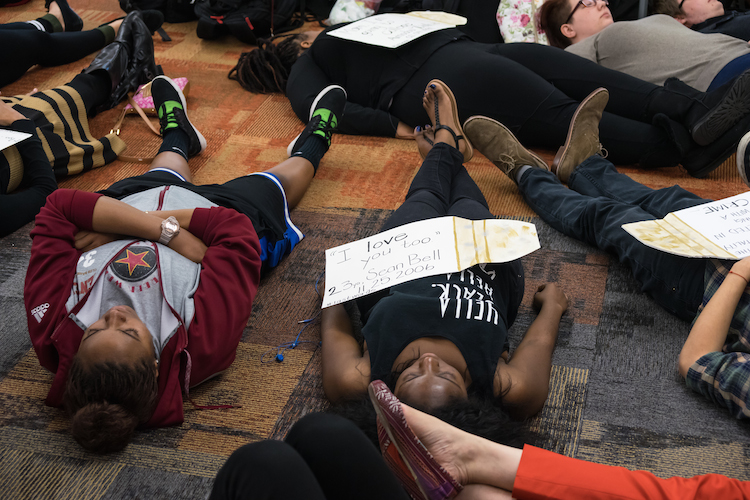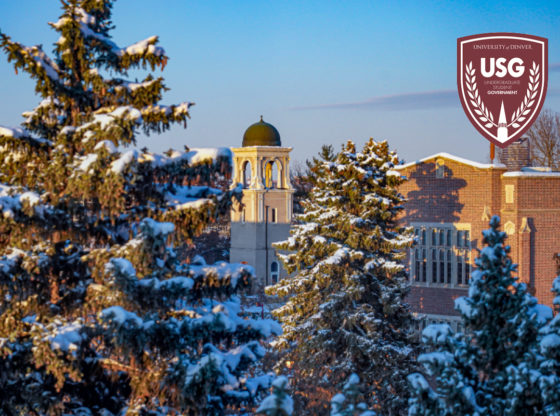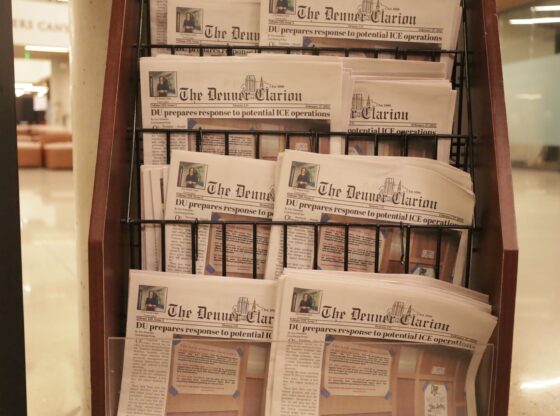On Monday, April 4 at 4 p.m. in the main lobby of the Anderson Academic Commons, the DU Black Graduate Student Association (BGSA) and Student Advocates for Institutional Change (SAIC) held a 16 minute die-in to bring awareness to not only physical, but mental implications of acts of racism, racial bias and microaggressions.
The date was chosen to commemorate the assassination of Martin Luther King, Jr. and each of the 16 minutes represented one of the bullets fired into Laquan McDonald, a 17-year-old black male who was killed by a police officer in 2014. McDonald was holding a three inch knife when he was shot 16 times in 13 seconds by Chicago police officer Jason Van Dyke. Van Dyke was charged with first degree murder shortly after footage of the fatal shooting was released, but he is currently out on bail and was hired at a Chicago police union, sparking outrage.
Similar demonstrations were held across the country, coordinated by a group of students at Argosy University, all tied together by the social media tag #psychologists4blacklives.
“Psychology students at Argosy sent an email asking people to stand in solidarity with those who are psychologically affected by seeing violence against black bodies and other acts of racism,” said first year graduate student of international and cultural communications Carolyn Coles, who is a member of BGSA and initially brought up and eventually helped plan the event. “There have been studies of what racism does to the mind in the classroom and on campus. It’s difficult to navigate college when you’re under attack or could be.”
At the DU event, about 100 undergraduate and graduate students, DU faculty, alumni and students from other universities gathered in the Anderson Academic Commons and laid down in silence for the 16 minutes while a video detailing the history of violence against black individuals played. Also featured around the site were the names and last words of black victims of police brutality, inspiring words from black leaders and statistics on police brutality.
“To get such a great turnout, especially because we had to plan the event in a week, was amazing. I think we expected about 20 people,” said Coles. “It really showed that black issues matter to more than just black people. When we brought up this grave injustice, students and faculty of all ages and races cared and came to support. It was empowering.”
The most powerful moment of the demonstration for Coles came during the 16 minutes in which people laid silently and simply listened to the video.
“[The most powerful moment was] the layering effect of the date being April 4 and being in a space with lots of people of different races and religions just silently listening to the video. It was a silently reaffirming space, validated by the people surrounding me,” she said.
The most powerful moment for other students came during this reflective time as well.
“As a black student, I feel like I operate on a margin; however, during the demonstration I felt like I was truly a part of DU, it wasn’t just my friends and I and then everyone else,” said Darren Harvey, a second year graduate student at the Korbel School of International Studies and president of BGSA, who also worked to plan the event. “When the video shut off, there was just this silence. It was a powerful moment.”
Jonathan Seals, second year MBA student, BGSA member and the vice president of SAIC, concurred.
“When you discuss race in class there’s often a push back, but the video was able to explain the history of violence against black bodies in a clear and concise way and everyone was just listening in silence. There was no room to argue, no room for push back, just the opportunity to listen and think,” said Seals.
According to Cole, the institution was very supportive in working with the demonstrators. Campus Safety was present at the event to make sure that everyone was safe, and the vice provost made an appearance as well.
“We want the university to be accountable for things that have happened here, such as the defacing of black issues on the community wall. There are things that happen in plain sight and out of sight and it’s important to talk about them,” said Harvey. “It was empowering for the administration to see that we had that kind of support.”
The vast majority of reactions from people around campus have been supportive, according to Cole, Harvey and Seal. Harvey indicated that he did receive some criticism from those who didn’t understand why the event was being put on or believed that the event didn’t include everyone that needed to be represented. However, Harvey said that he believed that if the individuals had gone to the demonstration, they may have rethought their positions.
For now, BGSA and SAIC are very happy with the results of the die-in.
“DU has spurts of activism that dies down, and we don’t want this catalyst to die away,” said Harvey, urging students and community members to remember that “allyship is action-oriented.”
As for plans for the near future, SAIC is hosting an event with social media justice group Project Ava called “A Night of Storytelling”, during which students will have the chance to tell their stories of discrimination, prejudice and alienation on campus. The event will take place on April 20 from 6 to 7 p.m.











